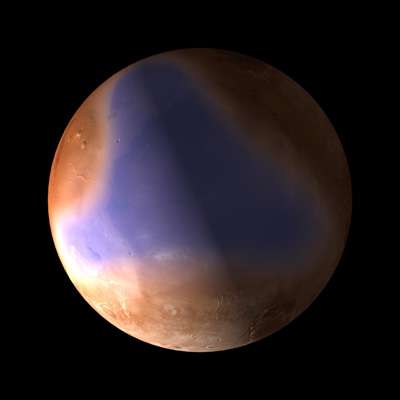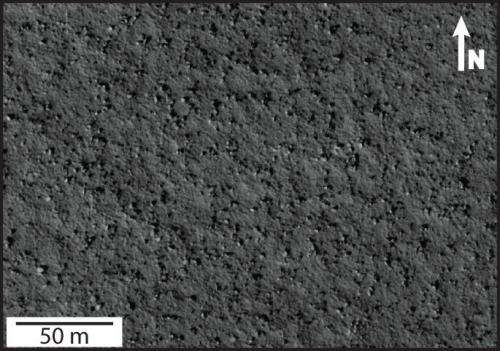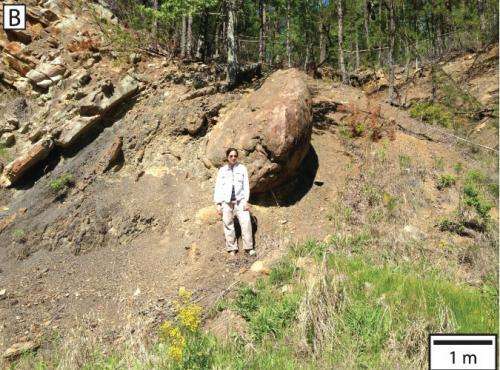New evidence for ancient ocean on Mars

Did a vast ocean once cover Mars' northern plains? The idea has been hotly debated among scientists for the past 20 years, ever since Viking Orbiter images revealed possible ancient shorelines near the pole. Later findings even suggested that the primordial ocean—dubbed Oceanus Borealis—could have covered a third of the planet.
But even if the evidence has mounted steadily, fostering our hopes of finding signs of past life on the Red Planet, the case for an ancient Martian ocean remains unsettled.
Now a new study by Lorena Moscardelli, a geologist at the University of Texas, Austin, puts forward yet another line of evidence.
Today, large fields of boulder-size rocks blanket parts of Mars' northern plains. By pointing to analogue geological features on our Earth, Moscardelli suggests that the boulders were delivered to their current locations by catastrophic underwater landslides—bolstering evidence for an ancient Martian ocean.
The boulders were spotted by the HiRISE camera on the Mars Reconnaissance Orbiter a while ago. So Moscardelli is not reporting their presence as something new, but rather a new interpretation of the processes behind their origin. The paper was published this month in a journal of the Geological Society of America.
Terrestrial Analogy
In the past, geoscientists thought of ocean sediments as mostly fine-grained, floating in the water column and settling like a slow "rain" on the sea floor, Moscardelli explained. But we now know it's not the only possible scenario.

"We know that 'submarine landslides' can transport big boulders—sometimes as big as a house—for hundreds of kilometers into the deep-water of the Earth oceans," she said. "Imagine a huge landslide affecting the entire state of Texas, but happening in the ocean."
In her new study, Moscardelli documents several sites where these events have occurred on Earth, such as the Pennsylvanian Jackfork Group of south-central Arkansas; the outcrops of the Guandacol Formation in the Pangazo Basin, Argentina; or in the Santos Basin, offshore Brazil.
She even shows that these underwater events can affect huge areas, as with a massive landslide that covered thousands of square kilometers in the Barents Sea, north of Russia, about a million years ago.
Some scientists have suggested that the boulders of Mars's northern plain could be the product of meteorite impacts. But to Moscardelli, that's not a fitting theory.
"That's possible for some of the boulders, especially those found close to craters," she says. "But how do you explain boulder fields that can cover thousands of square kilometers without any impact craters around? The submarine hypothesis provides a feasible alternative."
The Case for a Martian Ocean
In the 1980s, Viking spacecraft images revealed two possible ancient shorelines near the pole, much like those found in Earth's coastal regions. But further observations showed the coastlines varied in elevation, undulating like a wave, and thus casting much doubt on the Martian ocean hypothesis. However, later studies eventually showed that the deformation could be simply explained by the movement of Mars' spin axis.

What's more, the northern plains of Mars—also called the northern lowlands—lie at a lower elevation than the southern hemisphere, much like ocean basins found on Earth.
In addition to the boulders of the northern plains, Moscardelli had previously documented other geological features which can form underwater on Earth, including teardrop-shaped islands and polygon-shaped areas.
"There are many hypothesis out there and we still need to learn a whole lot before we can be confident about which one is right or wrong," she said. "I have an informed opinion based on my technical observations, but I am cautious and humble about it because I could be wrong! That said, I think my case is a strong one."
Some of the evidence for terrestrial analogues came from 3-D seismic surveys, a tool traditionally used by the oil and gas industry. So she hopes her approach will encourage more inter-disciplinary research.
"It is amazing to see how little the planetary science and the marine geoscience communities interacts," she said. "If anything, I hope my contributions can help improve that kind of cross-pollination and cooperation."
More information: Paper: www.geosociety.org/gsatoday/ar … 1052-5173-24-2-4.htm
Provided by Astrobio.net




















